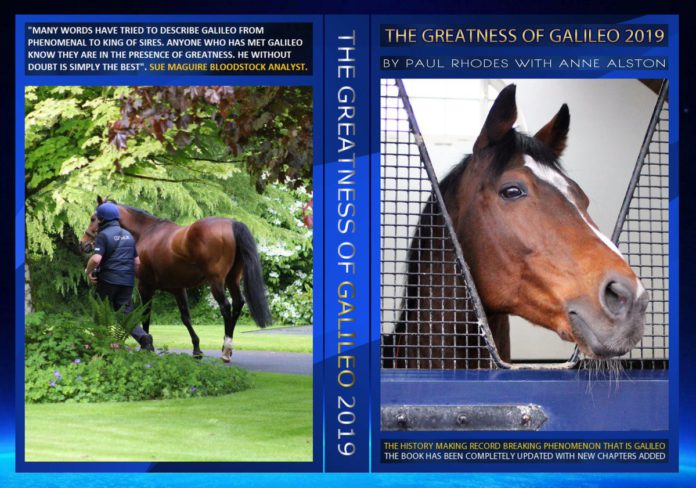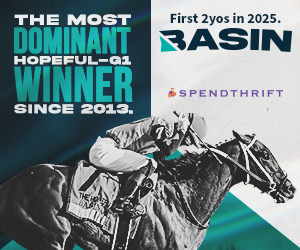
All the racing attention in Europe last weekend was focused on dual Prix de l’Arc de Triomphe winner Enable’s bid to win the Group 1 King George VI and Queen Elizabeth Stakes at Sandown. The Prince Khalid Abdullah-owned six-year-old mare obliged and made history by becoming the first horse to win the contest three years in succession. This is an incredible achievement and she may even add to her list of racetrack successes if she wins a third Prix de l’Arc de Triomphe in Paris in October.
Last weekend, however, also marked the 19th anniversary of the victory of Galileo, a son of Sadler’s Wells and Urban Sea, in what was then named the King George VI and Queen Elizabeth Diamond Stakes. Galileo won the Epsom Derby in England, the Irish Derby at The Curragh and the aforementioned King George VI and Queen Elizabeth Diamond Stakes during his three-year-old season. He was described at the time as being “one of the most impeccably bred horses in training.”
While his success as a three-year-old would see him crowned European Champion three-year-old colt in 2001, few could have imagined the effect he would have as a stallion on thoroughbred racing. The very mention of his name to any breeder or horse racing fan is greeted with reverence and honour. This is because Galileo is no ordinary horse, he is the ultimate sire of thoroughbreds, the most famous and sought-after stallion on planet earth.
An excellent source of information for those wishing to understand the Galileo story further is an fascinating publication called ‘The Greatness of Galileo’, by Paul Rhodes (with Anne Alston), founder and tireless administrator of the Aidan O’Brien Fan Site.
Rhodes, from Rosegreen near Cashel in Co. Tipperary, Ireland, was born and reared near Ballydoyle and Coolmore, the former being the training establishment of Aidan O’Brien, the latter noted as the world’s most famous breeding operation.
With Rhodes having a passion for all things Aidan O’Brien, Ballydoyle and Coolmore-related, he remembers with clarity the beginnings of the O’Brien era of success with winners such as Giant’s Causeway and Rock of Gibraltar. Despite having followed the career of Galileo the racehorse closely, he has pursued the life of Galileo the stallion in an obsessive manner, following the sire’s phenomenal success over the past decade.
Rhodes’ detailed publication shows the love and respect the author has for this special thoroughbred, detailing from the moment Galileo was born, covering his successful racing career on the track, as well as highlighting his amazing stud career which has seen him overtake his own sire Sadler’s Wells as flat racing’s ultimate stallion, and detailing his own progeny which includes Frankel.
This beautiful publication is divided into the six parts, with the first detailing Galileo’s birth and early life. A highly comprehensive account of the horses track career covers his racing life from the Irish Business Maiden Stakes for 2 Year Olds, through his dual Derby successes as a three-year-old, and concludes with his participation in the Breeders’ Cup Classic in the USA.
The sire’s stud career covers a total of 13 well-researched and details chapters. Each one shows Galileo’s progression and increased success as a stallion, providing information about his progeny at the sales, as well as enlightening readers about his own sons who are now successful and acclaimed stallions in their own right. The latter chapters of this section of the book are fascinating by their showing the amount of prize money won by his sons and daughters, as well as informing the reader about his progeny’s awards.
Towards the end of the book, Rhodes the researcher and statistician comes clearly into view with profile pages of Galileo’s 75 Group 1 winners, yes 75 Group 1 winners (at the time of publication, it is now nearly 90). Earlier this season, Galileo became the leading sire of Group 1-winning horses when he overtook Danehill at the top of the standings. What makes the former’s achievement so special is that he is a Northern hemisphere-only stallion, covering just one mare per day. The now deceased Danehill was a shuttle stallion, in other words, he covered mares in both the Northern and Southern hemispheres during their respective breeding seasons.
Flat racing is the source from which all future champions are bred. Horses by Galileo, the 11-time Champion sire of Ireland and Britain, the sire of almost 90 individual Group 1 winners, and the stallion whose progeny has more than 180 wins at the highest level, continues to dominate the sport in an exceptional way. ‘The Greatness Of Galileo’ explains just why.
‘The Greatness Of Galileo’ is available in digital format on the Amazon Kindle store while Amazon has paperback copies for purchase.



